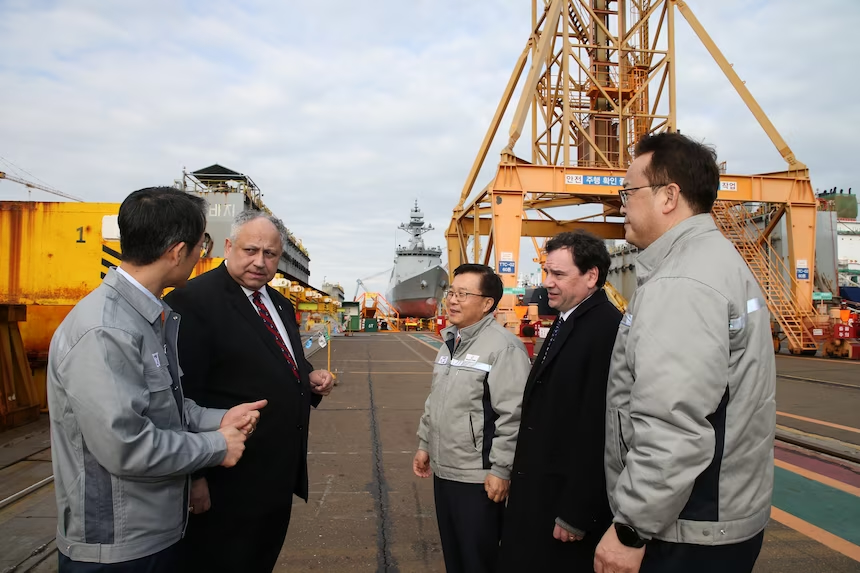
WASHINGTON, D.C. – Fresh off a Western Pacific tour of South Korean and Japanese shipyards, Secretary of the Navy Carlos Del Toro called for more allied foreign investment in U.S. shipyards and doubled down on criticizing the build rates of U.S. shipyards.
Del Toro toured both the Mitsubishi Heavy Industries shipyard in Yokohama and South Korea’s Hanwha Ocean’s and HD Hyundai shipyards during his Western Pacific trip and in statements encouraged Japanese and South Korean shipbuilding outfits to invest more in both U.S. commercial and naval shipbuilding.
On Thursday, Del Toro told an audience at the McAleese Defense Programs Conference that U.S. yards could learn from the Pacific yards in how to retain their workforces.
“What I took away from this visit was that we must explore any and all opportunities to expand our own shipbuilding capability, through competition through innovation and industrial capacity,” Del Toro said.
The shipyards “actually build the hospitals, the schools, the [child care centers], the bowling alleys, everything else you can imagine to try to attract workers to their shipyards and then retain them.”
Over the past month, Del Toro has been critical of U.S. shipyards over lapsed schedules and cost overruns that have delayed the delivery of ships under contract.
In a speech during WEST 2024, Del Toro said Department of the Navy suppliers have not invested enough in their infrastructure and instead put resources into stock buybacks and compensation for company leaders.
Overall, U.S. naval shipbuilders have invested about $5 billion in infrastructure improvements over the seven major shipyards across the country, according to data provided to USNI News from shipbuilders.
Shipbuilders across the country are having difficulty finding workers as older employees retire and retention for new people has been difficult. For example, to meet the goal of 2.33 Virginia-class submarines per year to meet the demands of both the U.S. and the AUKUS partnership, the submarine workforce has to grow by an estimated 100,000 workers across the country.
Del Toro continued to stress the infrastructure point on Thursday when asked about supply chain and workforce issues with submarine construction at HII’s Newport News Shipbuilding and General Dynamics Electric Boat.
“Two words: invest more. You’re not where you need to be,” he said.
“For those companies that are having problems in retention, damn it take better care of your people … If they can’t find housing in your local communities, well then work with the governments to build housing in the local communities to get about it. That’s what problem solvers do.”
Del Toro also called for foreign allies to invest in U.S. shipbuilding. He pointed to the Italian investments in Constellation-class frigate builder Fincantieri Marinette Marine in Wisconsin and the Australian investment in shipbuilder Austal USA in Mobile Ala. He said there are several locations across the U.S. that could use help from foreign shipbuilders.
“Competition is always good. I think there are several smaller U.S. shipyards that have gone dormant and perhaps are struggling and that could benefit from a cash infusion from international investors,” he said.
U.S. ambassador to Japan Rahm Emanuel has also called for more foreign investment in U.S. shipbuilding.
“There’s a closed plant in Philadelphia. There’s a closed Navy shipyard in Long Beach. And there are a couple of others,” Emanuel told Nikkei Asia during a tour of Mitsubishi’s yard in Yokohama with Del Toro
“We wanted to see if Mitsubishi and other Japanese companies would be interested in potentially investing and reopening one of those shipyards and being part of building Navy, commercial and Coast Guard ships.”
But it’s unclear what platforms the new shipyards would build. The Fiscal Year 2025 shipbuilding budget is expected to be flat, with the Navy buying eight or nine ships. U.S. commercial shipbuilding is largely limited to ships transporting goods domestically, as required by the Jones Act.
Instead of creating new yards, the president of the Shipbuilder’s Council of America said the Navy would be better served by using its existing yards.
“SCA believes the more strategic approach will be to put the maximum amount of volume through each of the shipyards to both build ships faster and repair ships on time. That’s more than possible with our existing shipyards,” SCA president Matt Paxton told USNI News this week.





